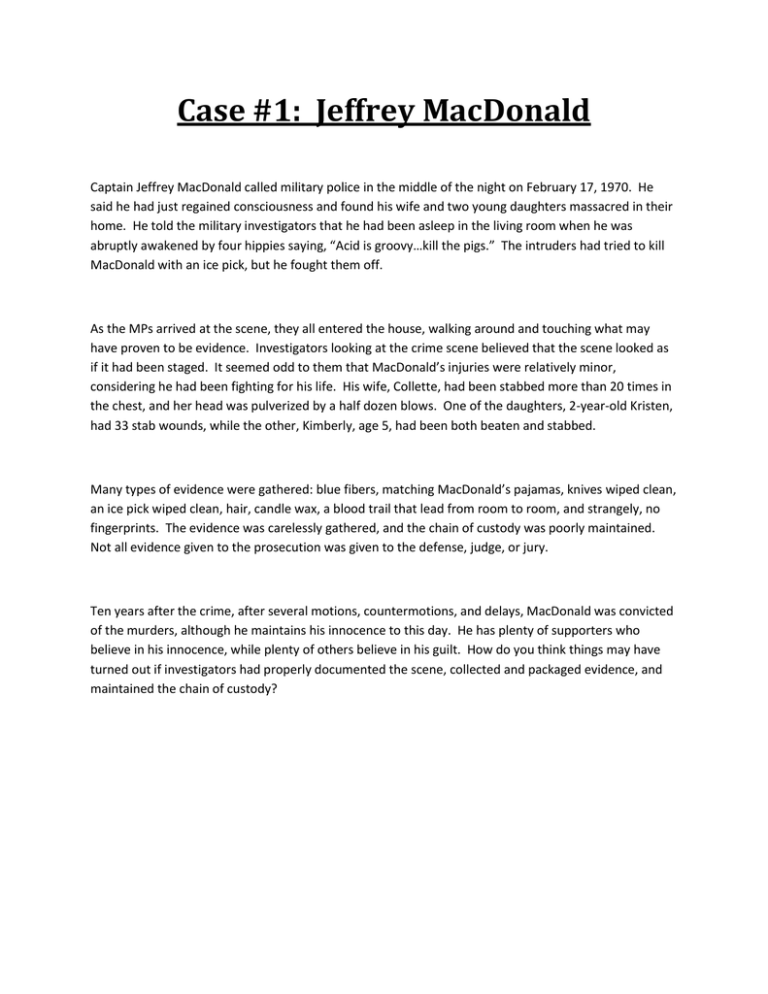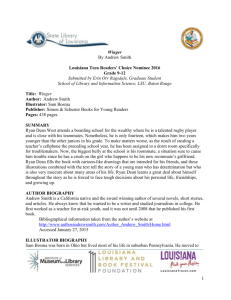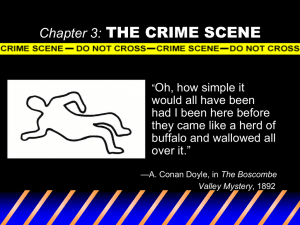Forensic Case Studies: MacDonald & Winger Crime Scene Analysis
advertisement

Case #1: Jeffrey MacDonald Captain Jeffrey MacDonald called military police in the middle of the night on February 17, 1970. He said he had just regained consciousness and found his wife and two young daughters massacred in their home. He told the military investigators that he had been asleep in the living room when he was abruptly awakened by four hippies saying, “Acid is groovy…kill the pigs.” The intruders had tried to kill MacDonald with an ice pick, but he fought them off. As the MPs arrived at the scene, they all entered the house, walking around and touching what may have proven to be evidence. Investigators looking at the crime scene believed that the scene looked as if it had been staged. It seemed odd to them that MacDonald’s injuries were relatively minor, considering he had been fighting for his life. His wife, Collette, had been stabbed more than 20 times in the chest, and her head was pulverized by a half dozen blows. One of the daughters, 2-year-old Kristen, had 33 stab wounds, while the other, Kimberly, age 5, had been both beaten and stabbed. Many types of evidence were gathered: blue fibers, matching MacDonald’s pajamas, knives wiped clean, an ice pick wiped clean, hair, candle wax, a blood trail that lead from room to room, and strangely, no fingerprints. The evidence was carelessly gathered, and the chain of custody was poorly maintained. Not all evidence given to the prosecution was given to the defense, judge, or jury. Ten years after the crime, after several motions, countermotions, and delays, MacDonald was convicted of the murders, although he maintains his innocence to this day. He has plenty of supporters who believe in his innocence, while plenty of others believe in his guilt. How do you think things may have turned out if investigators had properly documented the scene, collected and packaged evidence, and maintained the chain of custody? Case #2: Mark Winger After a strange two-hour shuttle-van ride home from the St. Louis Airport on August 23, 1995, Donnah Winger was stalked by the driver of the van, Roger Harrington. When she got home, she told her husband, Mark, about this incident. Six days after that ride, police were called to the Winger home, where they found Donnah Winger bludgeoned to death, Harrington shot twice in the head, and Mark Winger distraught. Mark Winger said that while he was in the basement, he heard a scuffle, ran upstairs, and found Harrington beating his wife with a hammer, so Winger shot him. The obvious conclusion was that because Mrs. Winger had complained to family, friends, and the airport limousine company about Harrington, he had come after her to retaliate. However, a crime scene site survey was done, and a three-dimensional, scale trial model was constructed and sent to the police department in Springfield, Illinois. The reconstruction depicted the distance between the two victims and Mark Winger’s path inside the residence during the time of the deaths. The exhibit also illustrated Mark Winger’s line of sight according to his statements, which were inconsistent with the evidence and physical layout of the residence. A visual information specialist from the Structural Design Unit testified as an expert witness to the truth of the reconstructed crime scene. As a result of these inconsistencies, Mark Winger was convicted of murder and sentenced on August 1, 2002, to life in prison without the possibility of parole. -from the 2002 FBI annual report Case Study Questions 1. What is the physical evidence in your case? 2. Using what you have learned, describe how the crime scene was contaminated. 3. List the inconsistencies of the suspect’s statement in your case. 4. Describe the inconsistencies you observe in the case. (i.e. how evidence gathered? Suspicions?) 5. Make a list of at least 5 questions regarding what information you would want to obtain that is absent from the case reading. 1) 2) 3) 4) 5)






